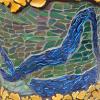Installations, Paintings and More at the MFA Exit Show

Ali Norman
A decades-long tradition of the Georgia Museum of Art and Lamar Dodd School of Art, the annual “Master of Fine Arts Degree Candidates Exhibition” showcases the creations of exiting students as they embark on professional careers. This year’s candidates are Katelyn Chapman, Whitney Cleveland, Annemarie DiCamillo and Kelsey Scharf (painting and drawing); Ally Christmas and Deepanjan Mukhopadhyay (photography and video); Yeonsoo Kim and Karine Lepage (ceramics); Erin Geagon and Johanna Norry (fabric design); Katherine Miller, Kaleena Stasiak and Ali Norman (printmaking and book arts); Elizabeth Rogers (Art X); Katlin Shae (sculpture); and Alexis Spina (jewelry and metals).
Recognized as a terminal degree, the MFA represents the highest level of academic training obtainable by aspiring artists, and several of the candidates demonstrate a strong vision in their field. Norman’s beautiful black-and-white intaglio prints of flora and fauna are simultaneously earthy and mystical through their intricate detail and symbolism. Kim modernizes the centuries-old craft of ceramics by challenging himself to create a new hand-built vessel or mask each day, resulting in a diary-like collection of unusual porcelain pieces decorated with narrative illustrations.
Multiple students choose to utilize materials beyond their academic focus. Sculptor student Shae creates handwoven textiles that incorporate fun materials such as metallic threads, pom-poms, VHS tape, beads and zip-ties. Photographer Mukhopadhyay’s body of work spans video, installation, sculpture and new media to convey ideas pertaining to identity, politics, labor and the transition from post-colonialism to neocolonialism.
Impressively, a few artists present multimedia installations resembling dioramas, offering three-dimensional environments for the viewer to become absorbed in. Norry built the claustrophobic bedroom scene “He Called Me Crazy” based off of a tragic incident that occurred within her own family. In 1949, her great-aunt Kathleen shot her then-ex-husband John Drewry, dean of the UGA Grady College of Journalism and a founder of the Peabody Awards, and his girlfriend Miriam Thurmond. Norry’s personal curiosity led to finding hundreds of newspaper articles detailing the events, as well as an archive at the UGA Special Collections Library full of letters John wrote in the early ’30s that frequently express concern over marital issues and Kathleen’s mental health.
Imagining this dark past eventually grew into the materialization of an unsettling installation that embodies elements of mental illness and patriarchal oppression. The floors are covered in newspaper clippings with a foundation of revealing headlines, while a rotary telephone provides an opportunity to invasively listen in on a recording of one of John’s private letters to Kathleen. Busily patterned wallpaper is accented with haunting silhouettes of Miriam and Kathleen’s former lover, Margaret H. Blair, while other men in Kathleen’s life—her son, her attorney, her psychiatrist—hang on the wall as embroidered witnesses to her unraveling. The most bizarre detail of the scene is an old armchair with long very threads embroidered on the worn patches to resemble Kathleen’s nerves spilling onto the floor. Beyond an investigation into family history, Norry’s installation demonstrates how the intersection of art and archive can influence collective memory.
Hanging on adjacent walls, the paintings of Chapman and Scharf reflect comparable influences of the rural South and working-class life. A series of three oil paintings by Chapman memorialize piles of crushed Busch, Budweiser and Bud Light cans, while “Dirt Rich,” appearing like a scene from a backwoods gas station, depicts a decapitated buck’s head and various cuts of raw meat chilling in a Pepsi cooler. While Chapman focuses on the rituals of everyday life made familiar by her hometown, Scharf’s body of work contemplates the disappearing histories of abandoned spaces. What began as a search in Athens for connections to her background as a factory worker in northwest Ohio led to the ruins of the Puritan Cordage Mill. Holding an unusual sheen, her oil paintings on copper speak to the use of industrial materials and document the natural decay and adaptive reuse of the space.
The Georgia Museum will host MFA Speaks on Thursday, Apr. 19 at 6:30 p.m. Each candidate will give a three-minute presentation offering insight into the concepts and processes behind their artwork, and will then be available in the gallery to answer questions from visitors. MFA Speaks will be immediately followed by Museum Mix from 8–11 p.m. In addition to refreshments and snacks, the free late-night art party features a dance party led by DJ Mahogany, who plans to spin a mix of soul, disco, funk, hip hop, rap and pop. After-hours gallery access also includes the exhibitions “Opera in Print: Fin-de-siècle Posters from the Blum Collection,” “Crafting History: Textiles, Metals and Ceramics at the University of Georgia” and “Images of Awakening: Buddhist Sculpture from Afghanistan and Pakistan.”
Keywords
- Georgia Museum of Art , Lamar Dodd School of Art, Katelyn Chapman, Whitney Cleveland, Annemarie DiCamillo, Kelsey Scharf, Alley Christmas, Deepanjan Mukhopadhyay, Yeonsoo Kim, Karine Lepage, Erin Geagon, Johanna Norry, Katherine Miller, Kaleena Stasiak, Ali Normal, Elizabeth Rogers, Katlin Shae, Alexis Spina
More by Jessica Smith
-

Art Around Town
A list of local art exhibits.
-

-

Art Around Town
A list of local art exhibits.









comments